Tangled
 for brief mild violence.
for brief mild violence.
Reviewed by: Scott Brennan
CONTRIBUTOR
| Moral Rating: | Better than Average |
| Moviemaking Quality: |
|
| Primary Audience: | Kids Family Teens Adults |
| Genre: | Family Animation Musical Comedy Kids Drama 3D Adaptation |
| Length: | 1 hr. 32 min. |
| Year of Release: | 2010 |
| USA Release: |
November 24, 2010 (wide—3,500+ theaters) DVD: March 29, 2011 |
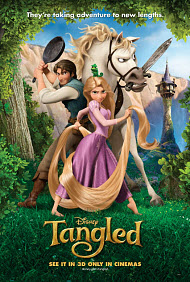

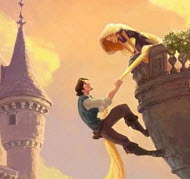

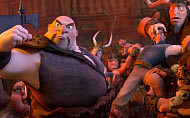
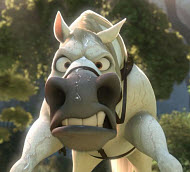
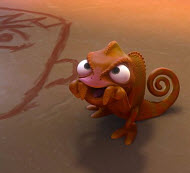
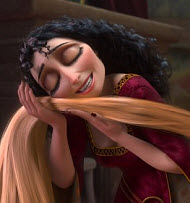
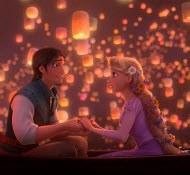
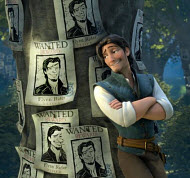
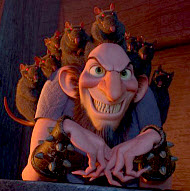
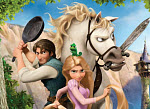
Royalty in the Bible:
| Featuring |
|---|
|
Mandy Moore … Rapunzel Zachary Levi … Flynn Ryder Jeffrey Tambor … Big Nose Thug Ron Perlman … Stabbington Brother Donna Murphy … Mother Gothel Brad Garrett … Hook-Hand Thug M.C. Gainey … Captain of the Guard Paul F. Tompkins … Short Thug |
| Director |
|
Nathan Greno Byron Howard |
| Producer |
|
Walt Disney Animation Studios Walt Disney Pictures Roy Conli John Lasseter |
| Distributor |
“They’re taking adventure to new lengths.”
“Tangled” is Disney’s first CGI Fairytale film and its 50th animated feature and will undoubtedly be a hit, despite it being the first in the “princess” genre to get a PG rating by the MPA. It definitely earned the rating due to the slightly violent overtones, but more on that later. In case you hadn’t heard, this movie was originally slated to be called “Rapunzel” after the infamous fairy tale by the Brothers Grimm.
As for storyline, the Disney version is really superior to the “grim” original (pun intended). By grim, I mean dark, pointless and somewhat boring. However, the “tangled” web that was woven around this film had nothing to do with hair, crème rinse, or conditioner prior to its release, but more about the right title and correct target audience. The consensus appeared to be that the name “Rapunzel” would be scrapped to give way to “Tangled” since the former would risk the film falling by the wayside like “The Princess and the Frog,” appealing to far more little girls and not so many boys.
By all accounts, Disney considered “The Princess and the Frog” as underachieving by their own standards—despite a $270 million worldwide purse and critical acclaim. They couldn’t risk that again, especially since they planned to put this genre to sleep after this film. My guess is that “Tangled” refers to the two characters becoming intertwined and not Rapunzel’s braids. The film begins with a single line from Flynn—immediately capturing the attention of any boys in the viewing audience: “This is the story of how I died…”
So changes were made, and “Rapunzel” became “Tangled” and the trailer and storyline put emphasis on the male character, Flynn Rider (voice by Zachary Levi), the high-flying male bandit who eventually becomes the hero and love interest of Rapunzel (voice by Mandy Moore). Flynn is a caricature of the real life Errol Flynn, a la the swashbuckling Robin Hood he portrayed in the 1938 film by the same name, which makes it an obvious appeal, not just to boys, but to an older generation as well, one who would recognize the name Flynn from yesteryear.
Creating the visuals for this eye-popping phenomenal film required advances and experiments in the industry similar to those James Cameron made in the making of “Avatar,” where tools and techniques didn’t exist when the project was started, but came into being out of necessity. The art demanded them, not just the executive producer, and creative director Glen Keane. From the onset, Glen planned on a film that looked and felt like the traditional Disney hand-drawn animations, only in 3D.
The only question was how were they going to achieve this? The vision was there, using the French rococo artist Jean-Honore Fragonard’s famous painting “The Swing” as the chief inspiration. It would be a lush and painterly style to capture the essence of a Romantic fairy tale world, yet they would keep the rounded edges and curves of brushstrokes from watercolors that characterized the traditional Disney animations. Keane credits animator Kyle Stawitz for achieving this balance and bringing to life a moving, Disney, painterly style film, a first in the world of CGI animation.
The plot and areas of concern
As stated earlier, Grimm fairytales are foreboding by nature, so the dark quality was expected, especially when it comes to Disney for creating the stark contrast between its protagonists and antagonists. Where there is an Ariel, there is an Ursula. And it is true for Rapunzel as well--where Mother Gothel (voice by Donna Murphy) portrays the darkest character in the film. She is the witch, the enchantress, motivated by her lusts and desires to achieve immortality if only by maintaining her youthful appearance, although it’s never explained for what purpose. (It’s the opinion of this reviewer that her busty, cleavage-bearing-image was a little overdone for the character she was playing. Did she have a night job?) She is the dominating dark mother of enmeshment and deception who has imprisoned Rapunzel, since the day she stole her away from her royal crib and hid her in a stairless tower. Although Rapunzel is unaware of these facts at first, she comes to learn of them throughout the story and sings of her dream, “When will my life begin?” as if she instinctively knows something is wrong.
The lies and deception that Mother Gothel uses to brainwash young Rapunzel move beyond common prevaricating. They are the worst kind of deception because they are lies that are covered with dialogue where Mother says things like, “I love you,” to evoke the response from Rapunzel, “I love you more,” so that Gothel can close the case with “I love you most,” an insidious form of control that will shortly come to sting Rapunzel’s conscience. That’s the one part of the film that I had trouble with. While Mother Gothel was truly a fraud and evil in every way, young Rapunzel didn’t really know that. Instead, Rapunzel deliberately left the safety of the castle against the authority set over her.
Once out in the real world she is experiencing a rift of emotions and thoughts that any girl would probably express in the same situation like, “I am a horrible daughter,” followed immediately by, “This is the best day ever!” Why was it the best day ever? Was Flynn right when he tempted her further with, and I’m paraphrasing here, “A little rebellion is normal; it’s part of growing up.” A clarifying conversation may need to take place after the film about all of this with regards to biblical authority in general, as well as the 5th commandment.
There are moments of mild violence throughout the film beginning with Rapunzel’s blackout hits on Flynn’s head with a frying pan, not once, but 3 times including tying him up in a closet with her hair and not even telling her mom about him. There was also a visit to the “Snuggly Duckling” which was basically a renaissance-faire like bar with characters who looked like the cross between the Capital One thugs on the TV commercials and all the Disney bad guys in past animated films—one of each—including one named “shorty” who stays inebriated throughout the film. The antics and dangers that Flynn and Rapunzel experience in the “Snuggly” were anything but. For a small child they could be quite scary.
Summary and spiritual significance
Before the bombardment begins with the howls of the respondents below whom may think I’m being too picky or prudish, let me say that there are plenty of endearing qualities in this remarkable film. First, the fact that it’s a musical makes the darker parts of the film feel not so scary, kind of like the songs in “The Wizard of Oz” did for me as a child. I could almost look at the witch knowing they were about to sing, “Lions and tigers and bears, oh my!” Alan Menken doesn’t disappoint with his memorable music either, although I have my doubts as to whether it will match the success of some of his earlier projects. Time will tell. There are some fantastic fun-filled-Irish-type-dance-scenes that make you want to join in as well.
Second, the characters, in general, are clearly differentiated in that you know who the bad guys are. That makes it simple to follow, especially for kids.
Third, there are many significant life lessons that can be learned for kids and adults of all ages, vignettes that can easily be discussed to bring the point home with ease, that include obedience, authority, lying, stealing, family, loyalty, forgiveness, vanity, anger, fear, resentment, rebellion, safety, strangers—to name but a few.
If you can get past the Disney product placements—what you know will be coming—like stuffed chameleons, the CSI super-sleuth horse Maximus (my favorite character), the scenes scattered throughout the movie that look like parts of different rides at Disneyland, or the entire film as the preview to the Broadway stage show, then you’ll probably love it. You have to suspend disbelief at some point. The little boy behind me in the theater yesterday said it best (I’m guessing he was 5), “Mommy, he is dead now… But he is still talking… That’s because of the magic, right mommy?” “Yes, son, that’s right.”
I think I can safely say that Disney hasn’t lost the magic…because way down deep inside “I have a dream.” Okay, I admit it; I’ve been humming this song from the movie for the past 24 hours. This was probably the best part of the film for me. The dream is alive. In due time, God will bring it to pass in our lives, if we wait patiently for it, and pray that we will see just what the proverbial “lanterns” in all of our lives actually represent. If these last two lines are unclear, it’s because it would be a spoiler for me to explain them. I chose to see the lanterns as the good works.
“For we are God’s workmanship, created in Christ Jesus to do good works, which God prepared in advance for us to do.”—Ephesians 2:10
Back in your court Mickey!
See list of Relevant Issues—questions-and-answers.


All that said, we loved this movie! We found it refreshing that the “witch” is not really a witch at all, but a selfish old woman, who happened upon a magic sundrop flower. See all »
Moral rating: Good / Moviemaking quality: 5
Moral rating: Better than Average / Moviemaking quality: 5
I took my two kids to see the movie, they absolutely loved it, I did too, specially Rapunzel and Maximus (the horse); these two stole the show. This one is absolutely going to have to be part of my kids DVD COLLECTION. If you can, go see it, you will not be disappointed.
Moral rating: Better than Average / Moviemaking quality: 5
In terms of honor your father and mother it could get confusing—but I doubt it. Really, if I was a step parent I might feel irritated. All the same, it would be nice if Disney made some movie with good parents in it. Really though, awesome movie. I like to read fairy tales but find most of Disney’s boring (I hate what they did to the Chronicles of Narnia). Finally, they made one I like. I took my 4 and 7 year old daughters and they loved it. Now I am going to take my wife (probably won’t take my son).
Moral rating: Good / Moviemaking quality: 5
See all »
Moral rating: Good / Moviemaking quality: 5
Moral rating: Better than Average / Moviemaking quality: 4
Yes, the mother was very mean and deceptive, but that emphasized to me that we are not always a product of poor upbringing as Rapunzel was sweet and innocent and very tolerant having not seen the outside world prior to 18. I don’t have any deep words of wisdom but only to say I really enjoyed this movie and would recommend it to others, AND I would really like to see it again myself!
Moral rating: Better than Average / Moviemaking quality: 5
When she did escape she struggled being torn between the abuse her “mother” put on her, and the fact that she wanted to be free. I got chills when she finally realized she was the lost princess that got stolen from the castle. I thought about how when we realize who we are in Christ, it can totally change our lives. When we see that we are children of the King, and we break free of our limited thinking, we can get set from from the prison we are living in. I thought it was awesome with a great message that was a pretty deep movie and funny.
Moral rating: Excellent! / Moviemaking quality: 5
Moral rating: Better than Average / Moviemaking quality: 4
An “incantation” is said in order to release the magic. I found the incantation similar to the spell in “Cinderella” and the curse in “Beauty and the Beast.” I did not, however, find the movie evil (as I personally found “Pocahontas” and “The Little Mermaid”). But you must decide for yourself if you are comfortable with the incantation or not.See all »
Moral rating: Average / Moviemaking quality: 4½
Moral rating: Better than Average / Moviemaking quality: 3½
Now, I have read other comments on here, so I have a few things to say. No, this is not a film for little tykes. Mother Gothel is very frightening and manipulative, though no more than Maleficent in Sleeping Beauty or the Evil Queen in Snow White. She is wholeheartedly evil, so there are no mixed messages about who is “good” and who is “evil” when it comes to her. Flynn happens to be a thief. So was Robin Hood. And like Disney’s Robin Hood, Flynn begins to see the bigger picture.See all »
Moral rating: Good / Moviemaking quality: 5
Complaints are given of the film’s magical themes, to which I say, what is magic, and for what reasons is it held to be evil? Well, it is held to be evil because God declares it so. But much of what God’s servants do in Scripture (healing the sick, raising the dead) would be considered magical by our standards. See all »
Moral rating: Good / Moviemaking quality: 5
Moral rating: Better than Average / Moviemaking quality: 5
Some points: There is a drunk character who is in it briefly.
~One song has jokingly violent lyrics, but I couldn’t even tell that until I had subtitles turned on.
~The character Flynn at one point encourages Rapunzel that it’s ok to be a little rebellious. There is very little troubling violence until the very end confrontation which may be bothersome to very young viewers. It is very brief.See all »
Moral rating: Better than Average / Moviemaking quality: 4½
I always look here for reviews before I take my children to any theater to watch a new release, and they know we will not see a movie until I can get reviews of it here first. I was a little confused by some of the review, but noticed no comments about rude behavior or grossness or language. This movie was fantastic! This is the cleanest movie since “Cars” or beyond. That is why it is still in theaters and no doubt will make more money than any movie currently out there whatever their rating. And I hope the movie makers take that into consideration in their next venture.
If you haven’t seen it, go before it leaves the theaters. I’ll be renting or buying it as soon as it comes out.
Moral rating: Better than Average / Moviemaking quality: 5
Moral rating: Good / Moviemaking quality: 4½
I’m not sure that I’ve ever seen a Disney movie so pro-Jesus. Sun is interchangeable with Son. It starts with the son. In the beginning was the word. A single drop of sunlight fell from the heavens. And from this small drop of sun grew a magic, golden flower. It had the ability… Jesus came to Earth to be born as a human. He had the ability to heal the sick and the injured. The flower is Christ.
Rapunzel then has the power of the flower in her, just as we have the power of Christ in us. She can heal the sick and injured, just as Christ’s apostles could because God gave them the power.
Moral rating: Better than Average / Moviemaking quality: 5
I liked the end where the main male character commented to his love that he “had a thing for brunettes,” See all »
Moral rating: Better than Average / Moviemaking quality: 5
Moral rating: Average / Moviemaking quality: 4½
That being said, I’m a little surprised at what some of the people are saying here. Most fairy tales do feature magic, and there’s nothing wrong with that because a lot of times, it’s not real magic. It’s not as though they laced it with anything remotely occultic a la Princess and the Frog. It was simple, fairy-tale, fantasy magic. And I hardly think it could be called blasphemous either.
As for the other issue about rebellion and the 5th Commandment, I’d like to point out that Rapunzel is 18 years old in the movie. Maybe it works differently in the world the movie is set in, but I’d say that qualifies her as an adult. I’d say it’s more about a girl trying to grow from dependent child to independent adult and having a “mother” that won’t let her.
So I fail to see a lot of reasons why this movie and the people who see it should be blasted with both barrels.
Moral rating: Better than Average / Moviemaking quality: 3
Moral rating: Extremely Offensive / Moviemaking quality: 4½
Moral rating: / Moviemaking quality: 4½
I wrongly assumed that this would be a cute movie about a girl exploring the world for the first time and falling in love with a handsome young man who initially rubbed her the wrong way. But, no, it was the usual Disney movie filled with magic, dark elements, and (like I said previously) blasphemy. I don’t know how the… reviewer could have given this movie a moral rating of better than average. How can a movie be “better than average” if it introduces precious young children to magic and takes the Lord’s attributes and power and gives it to plants and humans? There is nothing better than average about blasphemy, confusion, or “Tangled.”
Moral rating: Extremely Offensive / Moviemaking quality: 4½
The thing that left us with a bad feeling was the weakness of good compared to the strength of evil. Apart from righteousness of the horse, there is nobody who is both good AND strong in this film. The heroine is good, but not strong. The hero is both weak and morally dubious. The parents are good, but absent. This leaves our heroine grasping for help from the dark characters of the illegitimate mother and the villains from the wood. While miracle tears saved the hero so that he could take a bow for the curtain, they did not lift the mood of foreboding evil from the movie.
Moral rating: Offensive / Moviemaking quality: 4
Moral rating: Better than Average / Moviemaking quality: 5
Moral rating: Good / Moviemaking quality: 5
Moral rating: Good / Moviemaking quality: 5
Moral rating: Good / Moviemaking quality: 5
***END SPOILER***
It’s a nice movie with an ah-mazing message for all. It tells you that sometimes what you dream to be the best life ever isn’t actually what you need. Sometimes there’s more to life than you know and you have to be aware that your dreams sometimes aren’t “right” or you aren’t looking at the bigger picture (in a Christian’s life the bigger picture would be God.
Moral rating: Excellent! / Moviemaking quality: 5
***END SPOILER***
This movie worthwhile to spend money on.
Moral rating: / Moviemaking quality: 4½
***Spoiler*** When a few of the bad guys tie up the second main character (Flynn) to a boat and tell Rapunzel he left her with the crown he had stolen, I heard a child crying. (I’m not sure if this was just a coincidence or the child was crying because of the movie)
***End Spoiler***
This movie is just meant for entertainment. The violence was not bad either (the only “weapon” that every hurt anyone was a frying pan). Don’t take the magic seriously, it’s just for make believe.
Moral rating: Good / Moviemaking quality: 4½
Moral rating: Excellent! / Moviemaking quality: 5
Moral rating: Good / Moviemaking quality: 4½
Moral rating: Good / Moviemaking quality: 5
Moral rating: Better than Average / Moviemaking quality: 4
The one thing I did notice though is that the “mother’s” dress neck line goes a little low considering this film is made for young girls, especially. But it is a great movie, and I have watched it 5 times so far!
Moral rating: Excellent! / Moviemaking quality: 4½
Moral rating: Good / Moviemaking quality: 4½
Moral rating: Excellent! / Moviemaking quality: 5
Deuteronomy 18:9-12—9 “When thou art coming in unto the land which Jehovah thy God is giving to thee, thou dost not learn to do according to the abominations of those nations: 10 there is not found in thee one causing his son and his daughter to pass over into fire, a user of divinations, an observer of clouds, and an enchanter, and a sorcerer, 11 and a charmer, and one asking at a familiar spirit, and a wizard, and one seeking unto the dead. 12 For the abomination of Jehovah is every one doing these, and because of these abominations is Jehovah thy God dispossessing them from thy presence.”
2 Kings 21:6—And he made his son pass through the fire, and observed times, and used enchantments, and dealt with familiar spirits and wizards: he wrought much wickedness in the sight of the LORD, to provoke [him] to anger.
Isaiah 47:9—But these two [things] shall come to thee in a moment in one day, the loss of children, and widowhood: they shall come upon thee in their perfection for the multitude of thy sorceries, [and] for the great abundance of thine enchantments.
Nahum 3:3-5… Many casualties, piles of dead, bodies without number, people stumbling over the corpses—4 all because of the wanton lust of a harlot, alluring, the mistress of sorceries, who enslaved nations by her prostitution and peoples by her witchcraft. 5 “I am against you,” declares the Lord Almighty. …
Revelation 9:21—Nor did they repent of their murders, their practice of magic, their fornication, or their thefts. We have been warned!!! What to do with this magic? Get rid of it, or at least stay away from it at all cost.
Acts 19:19—And a number of those who had practiced magic arts brought their books together and burned them in the sight of all. And they counted the value of them and found it came to fifty thousand pieces of silver.
I will not expose myself or children (most importantly) to the variety of “darkness” in this Disney movie. I also put this in “positive” so those only looking for the good will see the bad in this movie.
Moral rating: / Moviemaking quality:

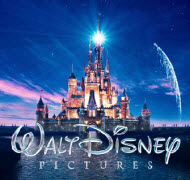
My Ratings: Moral rating: Average / Moviemaking quality: 5